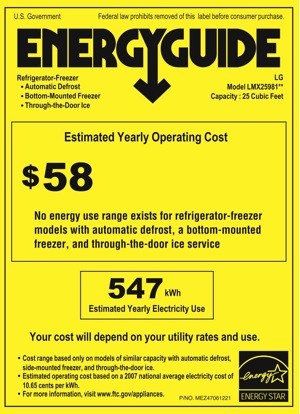You did your homework and bought an energy-efficient refrigerator.
It has the Energy Star rating, so you’re thinking that you might save some money on the electric bill and help to green your house by purchasing it.
You might be wrong.
[social_buttons]
In the October issue of Consumer Reports, “Save Energy, Save Money“, an article entitled “Energy Star has lost some luster” has stirred up some controversy. Consumer Reports rated one refrigerator as using 60% more electricity than the Energy Star label stated, and one, the LG LMX25981ST French-door fridge, as using more than double the energy on the label.
It turns out that according to the Department of Energy (DOE) procedures for testing, the refrigerator’s ice machine should be turned off during the test. Turning off the ice maker on some models, like the one tested, also turns off the cooling to the ice-making compartment.
Who buys a refrigerator with an ice-maker and then shuts it off?
The Consumer Reports article brings to light several points about the Energy Star rating:
- The qualifying standards are lax. About 25 percent of products in a category should qualify for the Energy Star, according to the EPA. But until recently, for example, 92 percent of all dishwashers qualified.
- Tests are not performed under working conditions. Ice-makers can be shut off for testing, and dishwashers used to be rated with a load of clean dishes, not dirty ones.
- Companies test their own products. The DOE does not test for compliance, and there is no independent verification.
- The procedures for testing are out of date. It takes about three years for the DOE to publish new rules, and three more for them to take effect. The technology of our appliances has out-paced the testing procedures.
Loopholes like these let manufacturers label their products as more energy efficient than they are, and they get the Energy Star to promote their “energy efficiency”.
In response to the article, the EPA had this to say:
The article misses the basic purpose of the ENERGY STAR program. ENERGY STAR helps consumers not just find energy-efficient products, but ones that will cost-effectively help them save money while protecting our environment.
Increasing the market share of qualifying products from their initial levels is a goal of the program — not a fundamental flaw or an indication that the requirements are lax, as the article suggests.
Consumer Reports responds:
We support the work of the DOE and the EPA with regards to the Energy Star program, but loopholes in testing procedures and lax standards have resulted in the issues highlighted in the article. We stand behind our article and repeat the call for the following:
- updated energy-use test procedures and standards
- independent verification of manufacturers’ self-reported test results
- a graded qualifying system for Energy Star
- tougher policing of standards by federal officials
Read the original article here: Energy Star has lost some luster
Read the EPA’s response here: Letter to the Editor of Consumer Reports
Consumer Reports guide: How to interpret the EnergyGuide label
Who ya gonna believe? The independent, non-profit testing expert, or the manufacturer of the appliance?
Related posts about Energy Star:

Living-off-the-grid, the Energy Star labels are pretty meaningless to us. When we are shopping for an appliance, the salesman can never tell us the watts or amp usage while in use, and they always just talk about yearly cost and usage. We have to climb behind the appliances to find the UL plaque. Yearly is irrelevant when you have a limited amount of power to use at any given time. Also, what’s up with most gas stoves having a 500watt heating element that runs all the time the gas oven is lit? Really, a huge power draw that is not needed; the gas is heating the oven.
Is there a rating system for energy usage that’s meaningful? The CR article is enlightening (and depressing), but there’s no mention of other gauges.
I asked a salesman once how many watts an electric massage chair used. His reply? “2 yen per use.” Now, since I know that a single use is 15 minutes, and that an average kWh in Japan costs 22 yen, I figured out the answer to my question. Problem is, that most sales people are trained to give you dollar amounts. Most people are too simple or uninterested to bother with things like kWhs. Heck, I bet most people you ask wouldn’t even know how many kWhs they use per month. They just see the bottom line, and then complain about it when the the costs they incur suddenly increase.
Jennifer, what kind of refrigerator do you use, if you use one at all? I am personally looking at copying an Australian gentleman’s idea of converting a deep freezer into a refrigerator. It would take some time and effort, but it apparently only uses 33 kWhs per YEAR~! Heck, mine uses double that in a MONTH!!!
Ryan, we use a Vestfrost/Conserv electric fridge.
http://www.conservrefrigerators.com/conserv.html
It is tall and narrow made in Denmark, I think. It is more efficient than most fridges, and it mostly fits in a normal fridge space, unlike the Sunfrosts that are more expensive, but use less power (I think) and usually have a six month waiting list. Our friends complain that their Sunfrost take forever to make ice, but the Conserv works great. Our Conserv is 11 years old. Once we had a propane fridge, but I really hated that, and propane is expensive.
Gene: I found this guide for electricity usage that can help you calculate the usage based on the power/UL label:
http://michaelbluejay.com/electricity/howmuch.html
Joining CR costs, but could be worth it if you are already investing in an appliance, but want to make sure it really is more energy efficient.
Cant trust the government? SUPRISE!